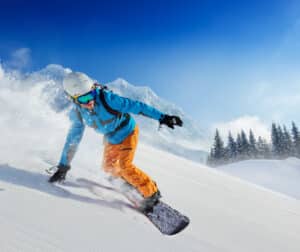 ☰ Menu
☰ Menu
The Western Slope of Colorado is a winter sports hotbed. Whether you enjoy skiing, snowboarding, ice skating, hockey, snowmobiling, sledding, snowshoeing or ice climbing, you have access to some of the best terrain and conditions. While these activities are a great source of fun, they can also be dangerous.
Each year, roughly 200,000 people are treated in doctor’s offices, hospitals and emergency rooms for winter sports injuries. Some of the most common injuries include fractures, joint dislocations, sprains, strains and concussions. Fortunately, many of these injuries are preventable. The following tips will help you reduce your risk of injury when participating in your favorite winter sports.
One of the best steps you can take to prevent winter sports injuries is to stay in shape. Core strengthening, cardiovascular exercise, strength training, and stretching and flexibility exercises can help keep your body in peak condition.
You should always cater your exercise regimen to address the muscles and joints used in your winter sport of choice. In general, exercises to strengthen your hips, core, feet and ankles will help build the stability you need for many winter sports. Yoga is also a great activity to include in your fitness regimen since it is excellent for balance, will help strengthen your core and stretch your hamstrings.
Cold weather can cause your muscles to tighten up and your blood vessels to contract. This increases the likelihood of cramping up or reaching the point of exhaustion during physical activity. Warming up will prepare your body for winter sports by increasing blood flow to your muscles and making your joints more limber.
Your warmup routine should last between 5-15 minutes and include a mix of stretching and light exercise to warm up your muscles. It’s always a good idea to cater your specific warmup activities to the sport you’re engaging in. For example, squats and lunges are an ideal way to activate the muscles being used for skiing, while warming up your arms may be more important before playing hockey or going ice climbing.

Other potential safety gear to use (depending on your winter sport of choice) may include:
Many winter sports require highly technical gear. Skiers and snowboarders need a good pair of skis/snowboard, boots and bindings. Ice skaters need high performance skates. Snowmobilers need a well-maintained snowmobile. Ice climbers need a good climbing harness, insulated boots, crampons to fit these boots, ice axes and belaying devices.
Old, defective, or poorly maintained gear won’t hold up under the rigors of your activity and may not deliver the technical performance you need. This not only makes it hard to enjoy your favorite winter sport, but it also increases your risk of an injury. Always make sure your gear is in good condition and working properly before you head out for the day.
The cold temperatures associated with winter sports require the right clothing to keep you warm and prevent frostbite. Always wear a thermal base layer made from moisture-wicking material that will keep you warm and dry. You should also have a thicker middle layer to help retain heat, and an outer shell layer that repels moisture and protects you from the wind. These layers should also be loose enough to allow you to move freely.
Staying warm is about more than just avoiding being uncomfortable or getting frostbite. It’s also critical to preventing injuries. When your body is very cold, your muscles become tight, and you won’t move as well. This can make it challenging to perform at top levels, and it may increase your risk of an injury.

Similarly, it’s important not to push yourself to the point of exhaustion. Whether you’re a beginner or a more advanced ability level, injuries are more likely to occur when you’re tired. Instead of pushing yourself to do that extra run or two at the end of the day, make the responsible decision to stop a little early before you get hurt.
While these tips are an effective way to minimize your risk of a winter sports injury, there’s always a chance that an injury will occur when you engage in strenuous athletic activities. At Colorado Advanced Orthopedics, we can provide the exceptional treatment you need to restore a pain free life and get back to your favorite activities as soon as possible.
You’ll receive treatment from a team of board-certified, fellowship trained orthopedic surgeons and sports medicine doctors who achieve some of the best patient outcomes in the state of Colorado. We use the most advanced medical techniques and the latest technology to ensure you receive the best care possible. Our ability to deliver medical outcomes that exceed industry standards is one of the primary reasons why Colorado Advanced Orthopedics has become the facility of choice for many individuals along the Western Slope, as well as a popular medical tourism destination.
Contact us today to schedule an appointment. Colorado Advanced Orthopedics serves patients in Meeker and throughout the White River Valley.
Subscribe to our monthly publication highlighting Life's Joy and getting back to your life. We feature health tips, being out and about, and bringing joy to daily life.
Subscribe